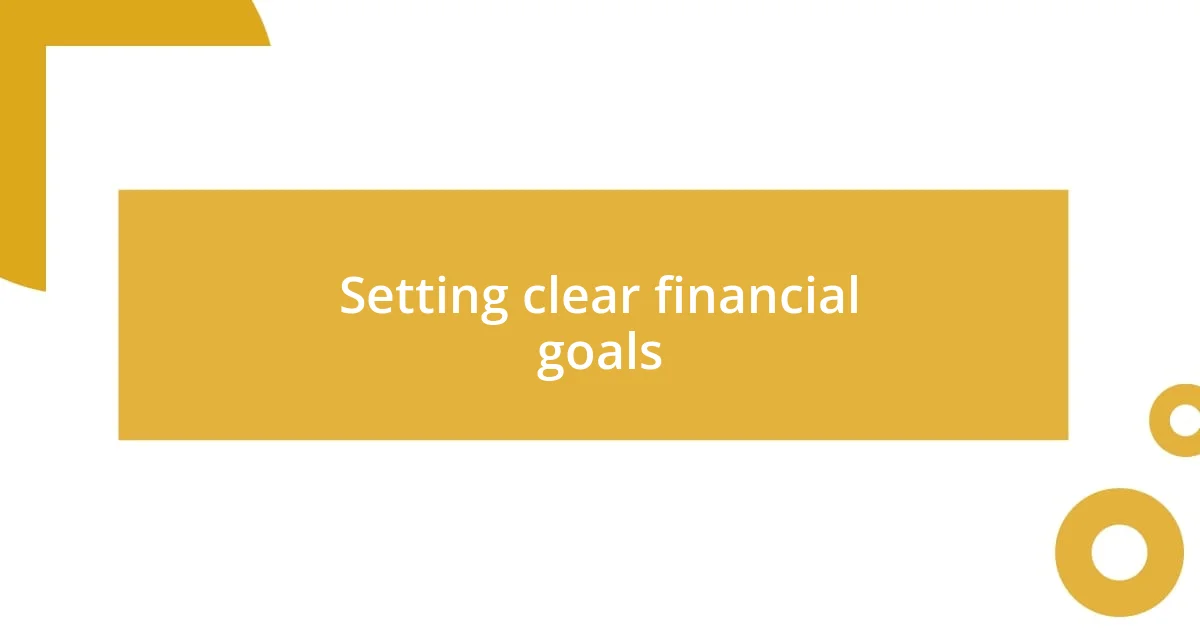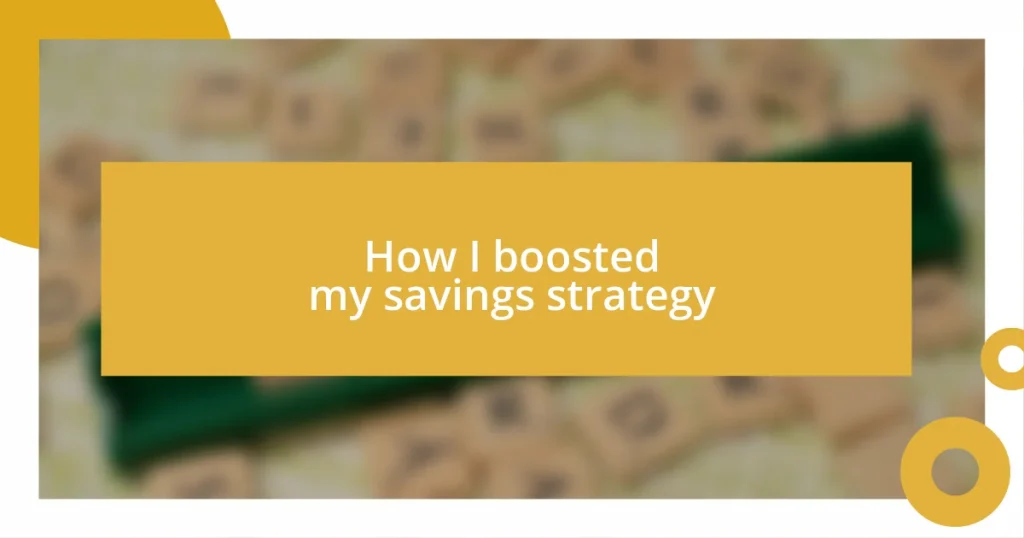Key takeaways:
- Embrace a flexible savings strategy, such as the 50/30/20 rule, to transform savings into an opportunity rather than a chore.
- Set clear, specific financial goals and break them down into manageable steps to maintain motivation and focus.
- Regularly track progress and adjust savings plans as needed to stay in control and motivated on the journey to financial stability.

Understanding savings strategies
Understanding savings strategies is all about finding what works for you and your lifestyle. I remember my early days of saving, feeling overwhelmed by the countless methods out there. Could I really stick to a strict budget or was a more flexible approach better?
One approach that resonated with me was the 50/30/20 rule, where I allocate 50% of my income to needs, 30% to wants, and 20% to savings. This strategy transformed my mindset; instead of seeing savings as a chore, I embraced it as an opportunity to build my future. Have you ever felt that rush when you set aside money and watch it grow? It’s like planting seeds for tomorrow.
Over time, I’ve learned that multiple strategies can mesh together beautifully. For instance, combining an automated savings plan with a high-yield savings account has allowed me to save effortlessly while earning interest. Have you considered how the right tools can enhance your savings journey? It’s empowering to watch your money work for you!

Setting clear financial goals
Setting clear financial goals is essential for any successful savings strategy. I recall a moment when I decided to write down my objectives—doing so transformed my efforts. I found clarity and motivation when I made these goals tangible. It felt like I was building a roadmap for my future, and I could almost visualize myself reaching those milestones.
Here are some key points to consider when setting your financial goals:
- Be Specific: Define exactly what you want to achieve. Instead of saying, “I want to save money,” try “I want to save $5,000 for a vacation in the next year.”
- Set a Timeline: Having a deadline keeps you focused and accountable. I remember setting a six-month timeline for a new laptop—it made saving more purposeful.
- Break It Down: Divide larger goals into smaller, manageable steps. When I aimed to save for a car, I focused on saving $500 each month, making the process feel less daunting.
- Make It Personal: Connect your goals to your values and desires. I realized that my saving for travel wasn’t just about money; it was about experiences and memories I wanted to create.
- Review and Adjust: Regularly check your progress and be willing to adjust your goals as life changes. I’ve found that reassessing my goals every few months helps me stay aligned with my priorities.

Creating a budget that works
Creating a budget that really works for you can feel like a daunting task, but I’ve found that the key is customization. One night, as I sat down with a glass of herbal tea, I realized my previous budgets didn’t quite reflect my lifestyle. I started by tracking every single expense for a month, which opened my eyes to where my money was actually going. Have you ever done this? It felt like turning on a light in a dark room; suddenly, I could see the areas that needed adjustment.
Another strategy I adopted was the “envelope method,” where I used cash for specific spending categories. In a way, this made my budget tactile, and I could physically see how much I had to spend. I vividly remember a month when I decided to limit my dining-out budget. By the end of the month, I had saved enough for a new book I had been eyeing. It’s incredible how these small adjustments can create a snowball effect in your savings journey.
To distill what I’ve learned, here’s a simple comparison table that highlights different budget approaches and their strengths:
| Budgeting Method | Strengths |
|---|---|
| 50/30/20 Rule | Flexible and straightforward. |
| Envelope Method | Tactile, helps control discretionary spending. |
| Zero-Based Budgeting | Every dollar is accounted for, promotes intentional spending. |

Automating your savings process
Automating your savings process is one of the game-changers I discovered in my financial journey. When I set up automatic transfers from my checking account to my savings account, it felt like a weight lifted off my shoulders. Suddenly, saving money became effortless; I barely noticed the funds leaving my account, which is sometimes a mixed feeling, right? It’s like having a little invisible hand nudging me toward my goals without me needing to think about it daily.
I remember one month when I decided to increase my automatic transfer to $200 instead of the usual $100. At first, it felt like a stretch, but I quickly adjusted. It was surprising how much I managed to adapt my spending to fit this new arrangement. Have you ever experienced that? It showed me that our mindset around saving can shift dramatically once we commit to a plan.
Now, I can’t stress the power of setting up a separate savings account specifically for this purpose. I distinctively remember when I created a “vacation fund” account, and it became my happy place—every deposit brought me closer to sandy beaches and new adventures. Seeing that balance grow was incredibly motivating. It reinforced my belief: the more automated your savings efforts are, the more you will be inspired to reach your financial dreams.

Exploring high-interest savings accounts
High-interest savings accounts have been a revelation in my savings strategy. When I first stumbled upon them, it felt like uncovering a hidden treasure. I mean, why let my savings sit stagnant in a regular account when I could be earning more just by moving them? I opened my first high-interest savings account after reading about how even a small increase in the interest rate could significantly boost my savings over time. Have you ever thought about how your money can work harder for you?
The difference in interest rates can be astonishing. When I compared my old savings account to a high-interest option, the numbers were clear. It was like going from a trickle to a steady stream. I remember deciding to transfer a portion of my emergency fund into a high-interest account. Watching that balance grow more quickly than I expected was thrilling. It reminded me of the importance of being proactive with my money, rather than passively letting it sit.
What I found particularly helpful was understanding the fine print of these accounts. For instance, some offer promotional rates that eventually revert to standard rates. I learned to read the terms carefully to avoid unpleasant surprises. It’s a bit like dating—initial attractions can fade if you’re not looking for the long haul! When I found a high-interest account with a competitive ongoing rate, it felt like a victory. Knowing my savings were not just safe but also working diligently in my favor made all the difference in my financial outlook.

Reducing unnecessary expenses
Reducing unnecessary expenses has been a key component of my savings journey. One practical step I took was to evaluate my monthly subscriptions. I was amazed at how many services I was still paying for but never used! Canceling a couple of those streaming services and that premium coffee subscription may not seem like a monumental change at first, but collectively, those little adjustments added up significantly over time. It’s a curious thing; how often do we pay for convenience without truly assessing its value?
Budgeting apps became my best friends as I started tracking my spending. One month, I discovered that I was dropping a small fortune on lunches out. I decided to meal prep instead, transforming my approach to both spending and nutrition. By concentrating on preparing my own meals, not only did I save money, but I also found joy in cooking which I never thought I would enjoy. Have you ever realized how much control you gain when you re-assess your habits?
I also began to prioritize my spending based on needs versus wants. For example, I swapped out impulse buys for planned purchases. I remember feeling so proud after choosing to invest in a good-quality jacket instead of settling for a cheaper one that would wear out quickly. It was an empowering realization to recognize that I can enjoy quality while saving—what’s not to love about that? Taking the time to consider what truly adds value to my life has been a rewarding practice, and it might just transform your financial landscape too!

Tracking progress and adjusting plans
Tracking my progress has been an eye-opening experience. I started by setting measurable goals for my savings, like aiming for a certain percentage increase each month. It felt rewarding to hit those targets; I’d treat myself to a little something—a nice dinner or a special coffee—nothing extravagant, but enough to celebrate my discipline. Have you ever noticed how small victories can motivate you to keep pushing forward?
I discovered the importance of regular check-ins to assess my financial health. Each month, I’d sit down with my budget and review where I was succeeding and where I needed to pivot. One time, I realized that a minor dip in my income required a reassessment of my savings goals. I decided to scale back a bit, which allowed me to maintain my focus without feeling overwhelmed. Adjusting my plans made me feel in control—like I was steering my financial ship rather than drifting along.
On occasion, I’ve felt disheartened when my progress didn’t measure up to my expectations. I remember a few months where my savings growth was slower than I’d hoped. Instead of giving up, I used those moments to reevaluate my strategies. I began exploring new savings options, like investing in a few conservative stocks. That shift not only reignited my motivation but opened my eyes to the diverse avenues for growth. Have you already considered alternatives in your savings strategy? I found that being flexible and open to change has been essential in this journey toward financial stability.














